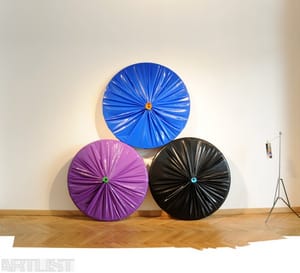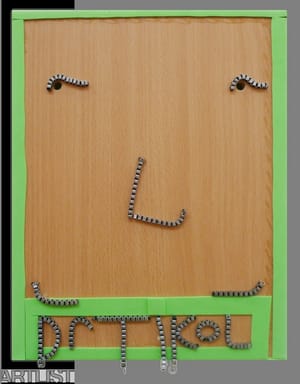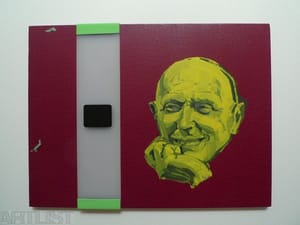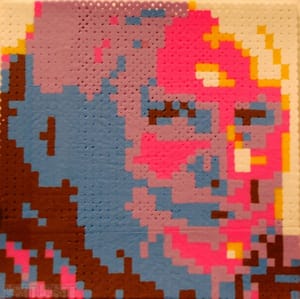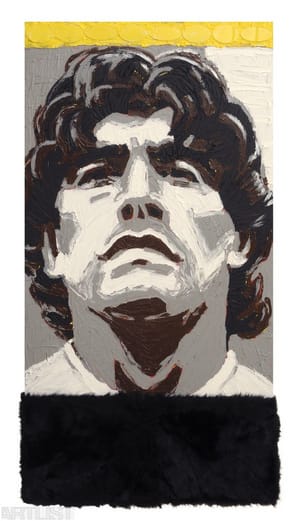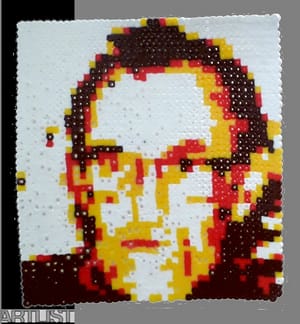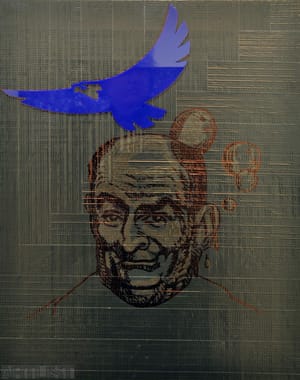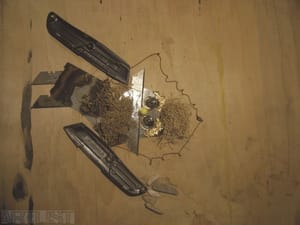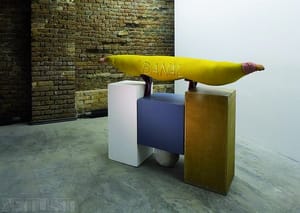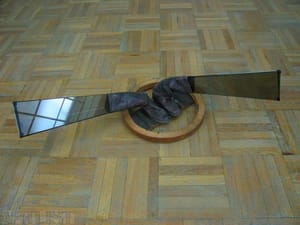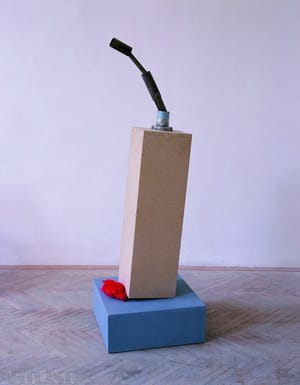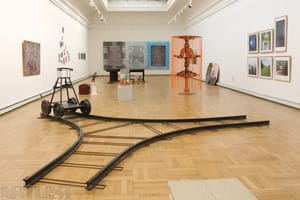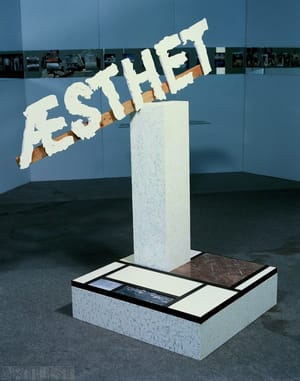- First Name
- Petr
- Surname
- Lysáček
- Born
- 1961
- Birth place
- Ostrava
- Place of work
- Ostrava and Prague
- Website
- www.lysacek.eu
- i-datum
- ↳ Find in the VVP AVU database
- Keywords
- CSU Library
- ↳ Find in the catalogue
About artist
Petr Lysáček arrived on the art scene in the 1990s and is one of the most important artists in the Czech Republic. He uses a wide range of media in his work (often mixing them together): installations, objects, photography, painting, video and performance. He had already made a name for himself while studying at the Academy of Fine Arts (AVU), where he was fully involved in the art world as a member of the Pondělí group (founded in 1989). The work of individual members of the group shared certain common elements, amongst other things a sense of distance, irony and humour. Though these qualities later disappeared from the work of certain members, Petr Lysáček’s oeuvre continues to display these features. At present Lysáček lives in Prague, though after completing his studies he lived for many years in his active Ostrava and had a large influence on the local scene (along with Jiří Surůvka). Along with other Ostrava-based artists he organised a host of controversial events, including the Malamut festival of action art, which became one of the most important shows of this type of art on the Czech art scene (1994-1998). Since 1994, Petr Lysáček has been head of the studio of intermedia forms at the faculty of fine art at Ostrava University, where he makes regular trips from Prague.
Petr Lysáček often works with ready-mades and new-dada, and uses these elements to undermine established form and content. He is a master at processing found objects. He recycles these objects and creates new links through his own interventions. Certain of his objects and installations express deeper spiritual symbols, which are then subjected to irony, a typical feature of his work. This applies in the case of an early installation entitled Crossroad (1993), in which the artist used a small bogey carrying a child’s highchair located on rails which spread out in three directions so making movement on the rails impossible. The highchair represents the world of the child, which, as opposed to adults, will find solutions to insoluble problems. The installation is a symbol of creativity – someone will find a way forward. The rails could continue into the unknown and the work involves the encounter of two realities: the first is the practical world, and the second is that which lies behind it.
Titled by the Sense and the Pedestal (2000) is an ironic object made up of found items, pedestals and iron pipes. The shapes are balanced precariously. The object, which features a simple composition, is Lysáček’s critique of minimalism. The artist’s objects are deliberately “anti-art” and often work with aesthetic ugliness, banality and kitsch.
Lysáček’s two-dimensional work features many “paintings” or “material images”, which are created using completely unusual techniques invented or developed by Lysáček. These are not paintings in the classical sense, but use unusual painterly techniques (spirit fix, silicon, etc.). A painting is often combined with 3D items, and so the work operates on the boundary between image and painting. A frequently recurring theme is the world of well known personalities. This is so in the case of Air Funes (2008), a portrait of the famous French comedian, who was famous in this country during Lysáčk’s youth. The technique of this “painting” is noteworthy: using a spirit fix Lysáček paints on a base comprising layers of rubber bands, while an eagle cut from plexiglass hovers above the actor’s head.
The cycle What Shall We Do With Them (2008) is also devoted to portraiture and features Czech and foreign philosophers (e.g. Petr Rezek, Ladislav Hejdánek, Václav Bělohradský, Emanuel Rádl, Jan Patočka, Egon Bondy, Miroslav Petříček and Edmund Husserl). Here too Lysáček drew on unconventional techniques: the faces are assembled from granular cylinders (purchased at Ikea), which were ironed with a hot iron after being placed in the picture. Black Hawk (2008), in which the artist “painted” an American helicopter in silicon using a smelting pistol, is another work on the periphery of painting. The title includes the word “black” because there is a black teddy bear located on the side of the picture (which the artist says fell into black latex paint). The title is therefore a semantic game.
We could continue forever enumerating the works in which the main role is taken by unusual techniques, recycling, and inventive games with materials and the significance of the objects on show. What is certain is that Petr Lysáček is one of the most inventive artists of the last twenty years. However, his works are by no means simply technical exercises. Thanks to Lysáček’s idiosyncratic humour and irony they make reference to absurdity and relativise generally accepted artistic values, thus raising questions regarding the meaning of art and life.
- Author of the annotation
- Ivona Raimanová
CV
Studies:
1987-1993 Academy of Fine Arts, Prague, Stanislav Kolíbal, Jiří Ptáček
1976-1980 Secondary Art School, Prague
Employment:
2003-2006 Institute for art studies, Ostrava University, Ostrava
since 1994 head of the department of intermedia, Faculty of Fine Arts, Ostrava University, Ostrava
1994-1998 Organizer of the Malamut Ostrava festival of action art,
participated in the Kabaret Návrat mistrů zábavy (Return of the Masters of Entertainment Cabaret)
Awards:
2006 Developmental grant of Tranzit
1993 1st prize, SCCA, Praha
Stipends:
2000 CSU stipendium, Čimelice
1994 NIA stipendium, organizováno MAAA Kansas City - NIA, Washington, D.C., USA
1992 Progetto, Civitella di Agliano, Italy
- Member of art groups included in ARTLIST.
- Member of art groups not included in ARTLIST.
-
1993-1996 Klub otevřené kultrury
od 1994 občanského sdružení MALAMUT,
1992-2005 Předkapela Lozinski,
1997-2001 Národní divadlo revival band (+ Kamera Skura).
od 2005 skupina František Lozinski o.p.s.(J.Surůvka, Fr. Kowolowski)
Exhibitions
- Solo exhibitions
-
2011
Je-li milej, Galerie Petr Novotný, Praha (Prague)
2010
8.2.16“, Americké centrum / US Ambassy, Praha (s Davidem Horanem)
„Who’s HOLY“, Brooks Gallery, Praha (s Davidem Horanem)
2009
lysacek@post.cz, CVUO, Ostrava
lysacek@post.cz, MKZ - Galerie Šternberk, Šternberk
2007
Co s nimi, Galerie Jelení, Praha
Co s nimi, Galerie Jáma 10, Ostrava
Fotograf, Galerie Fiducia, Ostrava
2005
Galerie Strážná věž, Ostrava ( with Fialová Denisa )
2001
Dům umění, Opava
Galerie Malovaný dům, Třebíč
2000
Nabídka P. Lysáčka do sbírek GVUO, KVT PDF OU, ateliér IMF, Ostrava
Galerie MXM, Praha
Galerie Půda, Český Těšín
1999
Galerie Jáma 10, Ostrava
Tři pruhy, Alliance Francaise, Ostrava
1998
Galerie MXM, Praha
Bílá lokomotiva - žlutá gorila, Galerie Fiducia, Ostrava
1997
Galerie Langův dům, Frýdek-Místek
Galerie Městské knihovny, Rožnov pod Radhoštěm
Galerie 761, Ostrava
Costeau TV, Kombajn, Ostrava
1996
Galerie Na Věčnosti, Znojmo
1995
Save the (Fe)male, Galerie Sklep, Ostrava
Rockový klub Cihelna, Ostrava
Pražákův palác, Brno ( with Surůvka J. )
Výstavní síň Sokolská 26, Ostrava ( with Horan D. )
1994
Galerie Fiducia, Frýdek-Místek
Sovinec ( with Pisařík P., Hlavina T. )
Okresní vlastivědné muzeum, Šumperk ( with Gabriel M. , Pisařík P. )
Galerie Na Půdě, Český Těšín
Czech out Memphis, Gallery of University of Memphis, TN, USA ( with Horan D. )
Galerie MXM, Praha
Divadlo hudby, Olomouc ( with Surůvka J.)
1993
Galerie Fiducia, Frýdek-Místek
1992
Galerie Studio Opatov, Praha
1989
Tři králové, Kulturní středisko ČKD Praha ( with Humhal P., Pisařík P. )
1987
Klub Delta, Ostrava
1984
Klub mladých obrancov vlasti, Bratislava
- Group exhibitions not included in ARTLIST.
-
2012-2013
Ř! Česká národní identita v současném umění, Galerie Vysoké školy uměleckoprůmyslové (Galerie VŠUP), Praha 1 (Prague)
2012
Ostrovy odporu: Mezi první a druhou moderností 1985 -2012, Veletržní palác, Praha (Prague)
2011
Retrospektiva Viktora Koláře, Moravská Galerie Brno, Místodržitelský palác, host
Nový zlínský salón, Galerie umění, Zlín
Palindrom, Walkthrugallery, Hradec Králové, (sk. F.Lozinski o.p.s.)
MOYA, Dvorak/Sec gallery-Koloredo Mansfeld palác, Praha
Přírůstky 2001-2011, GVUO, Ostrava
Transglobal Communication, DU Brno, mez. Performance festival
2010
City Dreamers, Galerie Emila Filly, Ústí nad Labem
The Gift, Karlin Studios, Praha
15 z Fiducie, piazzetta Národního divadla, Praha, projekt Ostrava 2015 / EHMK
Ostrava, město mé naděje, Evropský parlament, Brusel, B
Současná česká malba a socha, NG Veletržní palác, Praha
Dílna, sympozium, zámek Mikulov
Back to the Drawing Board, Geh 8, Dresden, D
Dlouhé vedení, Galerie Trisia, Třinec
Sebrané úvahy, Entrance Gallery / Karlin Studios, Praha
2009
Blaze.cz, Galerie VUT Starý pivovar,Brno, KP Pštros, Zlín, Galerie U mloka, Olomouc
2.Biennale Sztuki, GCK, Katowice, PL
Global Communication, Performance festival, Elektrownia, Radom, PL
Ostrava?, Pavilon A, Výstaviště Černá louka, Ostrava
Malamut, Performance festival, GVUO, Ostrava
Praha!!!, Ateliéry Úhonice
2008
Vjadačka, Galerie Minikino, Ostrava
Absence v záznamu, Galerie Václava Špály, Praha
2007
Forma následuje risk, galerie Futura, Praha
Ropovod 01, galerie E. Filly, Ústí nad Labem
Doghouse, Výstavní síň Sokolská 26, Ostrava
Wolnoscz, rownoscz, sztuka, galerie Szara, Polský Těšín, PL
Bienale sztuki dla decka, Poznaň, PL
2006
Kalendáře pro Jindru Štreita, Dům umění, Ostrava
25 let činnosti galerie Půda, Galerie Půda, Český Těšín
Mezi námi skupinami II, Dům umění, Brno
Fifty/Fifty, Neue Sachsische Kunstverein, Dresden, Germany
Cienie humoru, BWA, Bielsko Biała, Poland
Gury Mariackie, Galeria Szara, Cieszyn, Poland
OVA 95 - 05, Dům umění, Ostrava
Frisbee,Výstavní síň Sokolská 26, Ostrava
Cienie humoru, Galerie Awangarda, Wrocław, Poland
Frisbee, Dům pánů z Kunštátu, Brno
Art & Antikrist, Galerie VŠUP, Praha
Hermovov ucho, Dům umění, Opava
2005
IV. Nový zlínský salon, Zlín
Feed back, Performance festival, Galerie Justine Lacroix, Tohu-Bohu, Marseille, France
Infraction, Performance festival, Séte, France
Dresdner Kabaret, Riesa IFA, Motorhalen, Dresden, Germany
IBCA 2005 - Mezinárodní bienále současného umění 2005, Národní galerie, Praha
Frisbee, Galerie De Veemloer, Amsterdam, Netherlands
Nové přírůstky sbírek Galerie Felixe Jeneweina města Kutné Hory z let 1996-2004, Dům umění, Ostrava
Petr Lysáček, Vladimír Skrepl se studenty, Galerie Šternberk, Šternberk
2004
Frisbee, The National Museum of Contemporary Art Bucharest, Romania
Dresden-Ostrava 4:4, Důl Michal, Ostrava
Velký formát, Důl Michal, Ostrava
Velký formát, zámek Valtice
Contacts, Galerie Klatovy/Klenová, Klatovy
2003
Naši pražané nám rozumějí, Galerie Béhemot, Praha
Už žádné pinety vykukující z hlavy, Galerie Felixe Jeneweina, Kutná Hora
Wunderland, Hornické muzeum, Ostrava
Dvojitý nelzon, trojitý Mandela, Dům umění města Brna, Brno
Woonderland, LKAB, Kiruna, Sweden
Ostravská úderka, Galerie města Plzně, Plzeň
Hochsztaplerzy i outsiderzy…, Górnoslaskie Centrum Kultury - Galeria Sektor 1, Katowice, Poland
2002
tři + jeden zdrama, Galerie 761, Ostrava
Plenér - skupina Pondělí, Fotografická galerie Fiducia, Galerie 761, Výstavní síń Sokolská 26, Ostrava
Czescy outsiderzy, Galeria Arsenał, Białystok, Poland
Twenty@20, The Art Museum, The University of Memphis, Memphis, TN, USA
Heavy Metal Burza, Galéria Burizone, Bratislava, Slovakia
Nové přírůstky sbírek GFJ z let 1996-2001, Galerie Felixe Jeneweina, Kutná Hora
2001
Jak je důležité míti svého fotografa, Galerie Caesar, Olomouc
Súčasná česká serigrafia, Štátna galéria, Banská Bystrica
Velká přestávka - skupina Pondělí, Galerie G 99, Brno
Kolmo k ose, Dům umění, Opava
Nová media, Galerie G4, Cheb
Akční Praha - performance festival, NoD, Praha
Výtvarníci z Ostravy, Múzeum Vojtecha Löfflera, Košice, Slovakia
Výtvarníci z Ostravy, Považská galéria, Žilina, Slovensko
Jenewein - Kutná Hora, Galerie Felixe Jeneweina, Kutná Hora
Criss cross, Broumov
Objekt/Objekt, České muzeum výtvarného umění, Praha
Objekt/Objekt, Moravská galerie, Brno
Turniket - festival akčního umění, Galerie Eingang, Ostrava
8 z Ostravy, Galerie Caesar, Olomouc
Fast Art - Eine Schnelle Kunsterfrischung, Galerie Jáma 10, Ostrava
2000
Nevystavujte v roce 2000, Artlab J. Salák, Praha
Něco lepší než kosmetika, Veletržní palác, Praha
Performance festival Pražský parní válec 2000, Galerie MXM, Praha
Rezidenční pobyt CSU, Centrum současného umění Praha, Čimelice
Halda v Jámě, Galerie Jáma 10, Ostrava
Hnízda her, Galerie Rudolfinum, Praha
Festival Turniket, Galerie C.I. G. I. Ostrava, performance
Humusagnus, Galerie výtvarného umění Ostrava, festival
Na volné téma..., ale k věci, Galerie Václava Špály, Praha
Pocta Důl Michal Ostrava, Památkový ústav, instalace
Na koně, Galerie výtvarného umění Ostrava, objekt
Česká serigrafie, Galerie moderního umění, Hradec Králové
Česká serigrafie, Státní galerie, Zlín
1999
Perplex, Galerie Václava Špály, Praha
Podlahova OPEN 1999, katedra výtvarné tvorby PdF OU, Ostrava
Výstava prací učitelů a žáků KVT PdF OU, Velvyslanectví ČR v Sarajevu
Výstava pro zvířata, instalace, Galerie Sýpka, Vlkov
Následují zprávy o sportu..., Galerie Caesar, Olomouc
Malamut - performance festival, performance, Galerie 761, Ostrava
Vzdálené podobnosti, Veletržní palác, Praha
II. Nový zlínský salon, Dům umění, Zlín
Ostrava - Ústí nad Labem, Galerie Emila Filly, Ústí nad Labem
Obyčejné pohádky, Galerie U Bílého jednorožce, Klatovy
Náhodné známosti, Mánes, Praha
Neplánované spojení, Mánes, Praha
Jelinek Foundation, Mánes, Praha
Česká serigrafie, Dům umění, Opava
Zloty schilling, Dům umění, Znojmo
Česká serigrafie, Staroměstská radnice, Praha
1998
Česká serigrafie, Nová síň, Ostrava
Os & tráva, Múzeum Vojtecha Löfflera, Košice, Slovakia
Ostrava umjeni ...?, Dům umění, Ostrava
Ostrava umjeni ...?, Mánes, Praha
Medzi, Skalica, Slovensko
Sever proti Jihu, Galerie mladých U dobrého pastýře, Brno
Odpich, Galerie Langův dům, Frýdek-Místek
Česká serigrafie, Nová síň, Ostrava
Akční Praha, Roxy, Praha
Public space, Galerie Emila Filly, Ústí nad Labem
Malamut - performance meeting, Ostrava
SPU, Prostějov
A.K.T. II., mezinárodní festival, Brno
Limbo, Nadace Hermit Plasy, Plasy u Plzně
Společná mezinárodní akce, Nadace Hermit Plasy, Plasy u Plzně
Richard III. - společná divadelní akce, Skleněná louka, Brno
Výstava ze sbírky grafických listů Galerie 761, Galerie 761, Ostrava
1997
Snížený rozpočet, Mánes, Praha
Shake, Galerie Václava Špály, Praha
Workshop - SERIGRAFIE 97, Galerie Student, Ostrava
Shake, KC, Prostějov
Kolmo k ose, Ostrava
Permanentní performance, 1. festival akčního umění, Galerie 4, Cheb
A.K.T. I.; 1. Revoluční filtr, festival performance, Brno
MXM, Drážďany, SRN
Pedagogové KVT OU, Výstavní síň Sokolská 26, Ostrava
Nová media - retrospektiva, Polička
Malamut - performance meeting, Ostrava
1996
V. Konfrontace, Svárov u Kladna
I. Nový zlínský salon, Dům umění, Zlín
Mrkačka, Galerie MXM, Praha
Poruchy - laboratórium III, bývalá psych. klinika, Košice, Slovensko
Housing, 4711 Haus, Köln, SRN
The Skin of the white Lady, Eidhoven, Netherlands
Autosalon, Černá louka Pavilon C, Ostrava
Malamut - performance meeting, Ostrava
Pedagogové KVT k 5. výročí OU, Nová radnice, Ostrava
1995
Zkušební provoz, Mánes, Praha
Čistý zisk - reklama jako strategie stylu, Galerie MXM, Praha
Malamut - performance meeting, Ostrava
Maikäfer Flieg, Hochbunker Köln-Ehrenfeld, SRN
Otevření nového prostoru NG, Veletržní palác, Praha
In Search of Elvis, Delta Axes Gallery, Memphis, TN, USA (s D. Horanem)
Artcircolo, Zámek, Mělník
B & others, Galerie kavárna Velryba, Praha
1994
Czech of Memphis, Art Museum, University of Memphis, Memphis, TN, USA
Symbols of three generations, GMK, Katowice, Poland
Malovaný dům Třebíč
Cosido Y Crudo, Museo National Centro de Arte Reina Sofia, Madrid, Španělsko
Malamut - performance meeting, Ostrava
1993
Zweiter Ausgang - Second Exit - Druhý východ, Ludwig Forum, Aachen, SRN
Jako ženy, Nová síň, Praha
Krajina v současném výtvarném umění, Dům U kamenného zvonu, Praha
Post Security, Galerie 5020, Salzburg
Pondělí, Window Gallery - British Council, Praha
Situation Prag, Kampnagel-Internationale Kulturfabrik Hamburk, D
To, co zbývá, Štenclův dům, Praha
Galerie MXM, Letná, Praha
1992
Lysáček Petr, Písařík Petr, Nesázal Michal, Turek Filip, Galerie MXM, Praha
Prešparty, Umelecká beseda, Bratislava
Prešparty, Nová síň, Ostrava
Prešparty, GHMP Staroměstská radnice, Praha
Sirup - Junge kunst aus der Tschechoslowakei, Pasinger Fabrik, München, SRN
Mezi Ezopem and Mauglím, Galerie Václava Špály, Praha
Její bratr, jeho manžel, Galerie Václava Špály, Praha
35, Nová síň, Ostrava
Second Exit, Cáchy, SRN
Progetto, Civitella d A., Itálie
1991
Nová intimita, ÚLUV, Praha
Pondělí, Galerie M+, Bratislava
Junge Kunst der 80er Jahre aus der Tschechoslowakei, Galerie der Künstler, München, SRN
Aller Art, Galerie 68elf, Köln, SRN
1990
Antisalon, Černá louka, Ostrava
Medicinskaja Medhermeneutika + Pondělí, Galerie U Řečických, Praha
AVU, Vídeň, Austria
Pondělí, Pohlhammer Gallery, Steyer, Austria
AVU, Dům U Hybernů, Praha
1989
III. Konfrontace, Svárov u Kladna
1987
Konfrontace VI., Praha-Vysočany
1985
Konfrontace III., Kladno
- Collections
-
Wannieck Gallery, Brno
Galerie Klatovy/Klenová, Klatovy
Galerie Felixe Jeneweina města Kutné Hory v Kutné Hoře
Moravská galerie, Brno
NG-Veletržní palác, Praha
GHMP Praha
Forum Ludwig Aachen
GVU Zlín
Galerie výtvarného umění v Ostravě
private collections in the Czech Republic, Europe and US
- Other realisations
Actions / Performances:
2000
Zvuková konference, Galerie NoD, Praha (Prague)
60. - 80. versus 90. léta, Kostel Sacre Coeur, Praha
Monography
- Monography
lysáček@post.cz, katalog výstavy, Galerie výtvarného umění v Ostravě, 2009
